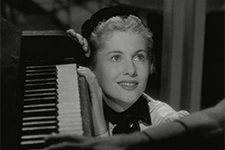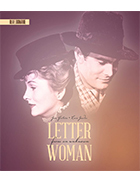Letter From an Unknown Woman
|  Letter From an Unknown Woman was one of four films the German-born Max Ophüls directed during his brief stint in Hollywood in the late 1940s. After fleeing Nazi Germany in 1933 after the Reichstag fire, where he left behind a successful career in both film and theater, he resumed filmmaking in France, Holland, and Italy. However, when France fell to the Nazis, he fled Europe entirely, this time landing in the United States at the tail end of the long progression of artistic exile that resulted in hundreds of European writers, actors, directors, and cinematographers looking for work with the Hollywood studios. Under the credited name Max Opuls, he made his first Hollywood foray with the Douglas Fairbanks Jr. swashbuckler The Exile (1947), but it was a mostly anonymous effort with little display of Ophüls’s unique aesthetic that makes use of visual repetition and long, complex tracking shots. Letter From an Unknown Woman is a much more distinctly Ophüls work, to the point that it fits neatly as the middle entry of an unofficial trilogy of films based around doomed romance, the other two being Liebelei (1933), which is his most famed work from his German period, and Madame de … (1953), which he made upon returning to France after the war. Like those films, Letter From an Unknown Woman is a “woman’s film” that privileges the perspective of the female protagonist, so much so that one could argue that the film is her dream of herself, every moment and every spoken word filtered through a tormented memory that casts herself as a kind of masochistic, yet unblemished romantic martyr. In this regard, it is an incredibly difficult film, one that constantly challenges identification and roots without mercy into the darkest underside of romantic passion. Based on the 1922 novella by Stefan Zweig, the film is set largely in fin-de-siècle Vienna, which provides an appropriately exotic backdrop for its dark tale of l’amour fou. The letter referenced in the film’s title has been written by a woman named Lisa Berndle (Joan Fontaine) to a man named Stefan Brand (Louis Jourdan), whose reading of it late one night provides the film’s narration. Lisa is “unknown” to Stefan, but only because he does not remember her. As we will gradually learn, Stefan actually knows her quite well, but because he is a shallow, self-absorbed womanizer who is constantly seeking, but unable to recognize, any source of stability in his life, she is just one more fleeting face among hundreds, lost in the fog of his memory. The story spans roughly 18 years of Lisa’s life, beginning when she is an adolescent living with her widowed mother (despite the character aging from 12 to 30, Joan Fontaine plays her at every stage of life). Stefan, a famous pianist, moves in next door, and Lisa is immediately captivated. She watches him when she can, listens to his music through the wall, and attempts to enrich herself with knowledge and cultural experience so that one day she might interject herself into the constant parade of women Stefan leads up the stairs into his apartment. As a teenager, Lisa is forced to move away from Vienna and her beloved object of desire, but as soon as she is an adult, she moves back with a single-minded focus on finally being seen by him. And one night, after she stands on the street under his window, he does see her, and they spend a long evening together that promises to be the start of an intense romance. Alas, as playboys are wont to do, Stefan disappears soon thereafter, leaving Lisa pregnant and alone. She bears the child, raises him herself while refusing to ask Stefan for assistance, and eventually consents to marry an older, wealthy man (Marcel Journet) who is willing to accept her, her son, and her past. Lisa’s seemingly secure, comfortable life is upended when she happens to see Stefan at an opera one night, which instantly propels her back into her romantic obsession, even as she must face the reality that, despite Stefan having dominated her thoughts for the better part of two decades, she exists in his mind as little more than a phantom, one he feels but cannot place. The film’s painful final moments find Stefan finally “seeing” her for the first time after reading her letter, except only as a ghostly image standing behind a door. It is a deeply poignant image, one that conjures the past as a means of both punishing and redeeming Stefan and Lisa’s unrequited love for him. That hopeless, endless romantic obsession would seem to make Lisa an insufferable character (as Pauline Kael memorably wrote, “there are moments when one wants to clobber the poor wrong, suffering creature”). But, Fontaine’s commitment to Lisa’s innocence and Ophüls’s visual artistry transcends what could have been either simply mawkish or downright creepy. Because everything is filtered through Lisa’s subjectivity (we never see her through anyone else’s eyes, even in intimate conversations), the film takes on a dreamlike aura, which is underscored by Ophüls’s fluid camera movements, ornate compositions, and intense lighting schemes. There is something slightly unreal about Lisa’s obsession; it isn’t romanticized, per se, but rather elevated into a transcendent world outside our own. Ophüls does not shy away from the problematic nature of Lisa’s obsession, and he neither condemns nor celebrates it. Rather, he presents it through the interaction of Lisa’s self-conscious narration and his own self-consciously stylized images as a complex evocation of the fragility of human connection and the power of memory. Stefan’s interpersonal myopia ensures his demise as well as Lisa’s, as did Hollywood’s Production Code, which insisted that the story’s illicit extramarital sex result in explicit punishment for all involved (there was some consternation in the Production Code Administration over the film, with head Joseph Breen, on a three-month sabbatical, having to intercede and overrule acting head Judge Stephen S. Jackson, who refused to give it a Seal of Approval unless Lisa recited a monologue of his own writing). The film was also worked over by the editors and producers, despite Ophüls fighting for final cut, which is why some of its most beautiful shots feel at times truncated or incomplete. This is not to say that there are not moments of sublime beauty throughout, one of the most memorable being the paired tracking shots at two different points in the film, the first of which shows Lisa watching Stefan walk another woman up the stairs to his apartment, and the second of which shows the exact same action, except this time Lisa is the woman and there is no one there except us to watch. It’s a powerful moment of visual connection that simultaneously brings to fruition Lisa’s most fervent desire while also sealing her doom.
Copyright © 2017 James Kendrick Thoughts? E-mail James Kendrick All images copyright © Olive Films | |||||||||||||||||||||||||||||||
Overall Rating: 


 (3.5)
(3.5)


